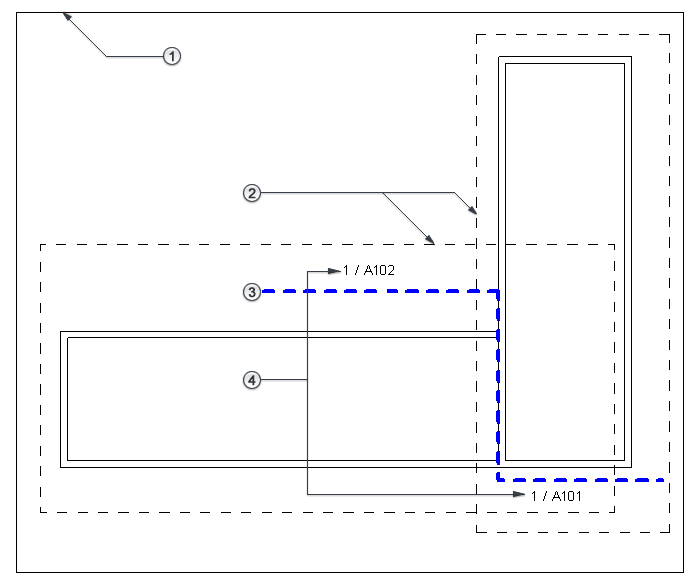You can create multiple copies of a view that are dependent on the primary view.
All copies, known as dependent views, remain synchronous with the primary view and all other dependent views, so that when view-specific changes (such as view scale and annotations) are made in one view, they are reflected in all views.
Creating dependent views may be useful in the following scenarios:
- You are working on a large project with an extensive floor plate, and you want to crop the view into smaller segments so you can place them on sheets. When you make changes to dependent segments of the view, you can quickly see how they affect the view as a whole by looking at the primary view.
- You need to place a view on more than one sheet.
Dependent views display in the Project Browser under the primary view. You can insert matchlines to indicate where the view is split, and view references to link views.
Example
The following image shows a project view that has been split into 2 dependent views. The primary view is shown in the drawing area with its crop region and the crop regions for the dependent views visible, a matchline indicating where the view is split (dashed blue line), and view references (1/A102 and 1/A101).
 Crop boundary of the primary view
Crop boundary of the primary view
 Crop boundaries of the dependent views
Crop boundaries of the dependent views
 Matchline
Matchline
 View references
View references

Supported View Types for Dependent Views
You can create dependent views for plan views, elevation views, section views, and callout views. When you create dependent section, elevation, or callout views, a new section, elevation, or callout symbol is generated on top of the original symbol. You can move the new symbol independently.
Visibility and Graphic Settings for Dependent Views
When you add view-specific information to a primary view or a dependent view, it is visible in all related views. You can specify visibility and graphic overrides to individual elements on a per-view basis. This allows you to clean up areas where there is overlap between related views. For more information, see About Hiding Elements in a View.
Dependent Views and View Properties
A dependent view inherits view properties and view-specific elements from the primary view. Synchrony is kept between the primary view and dependent views for the following view properties:
- View Scale
- Display model
- Detail Level
- Visibility settings
- Visual Style
- Graphic Display Options
- Hide at scales coarser than
- Underlay
- Underlay orientation
- Wall Join Display
- Discipline
- Color Scheme Location
- Color Scheme
- Phase Filter
- Phase
- Associated Level
- View Template
- View Range
- Depth Clipping
- Far Clipping
- Far Clip Offset
The following properties can vary between the primary view and dependent views:
- Orientation
- Identity Data properties (with the exception of View Template)
- Extent properties (with the exceptions of View Range and Associated Level)
- Scope Box (excluding section and elevation views)
- Project parameters
- Shared parameters
